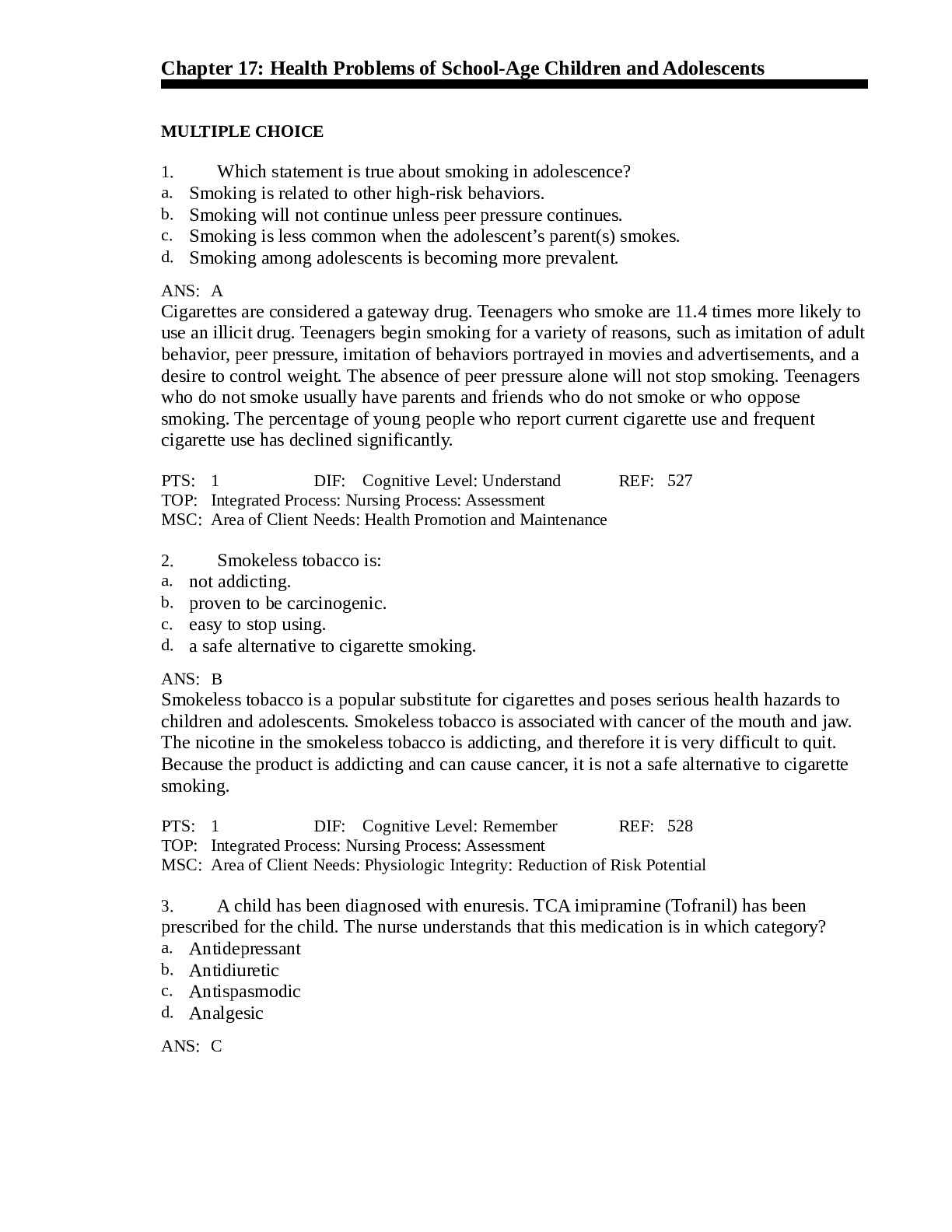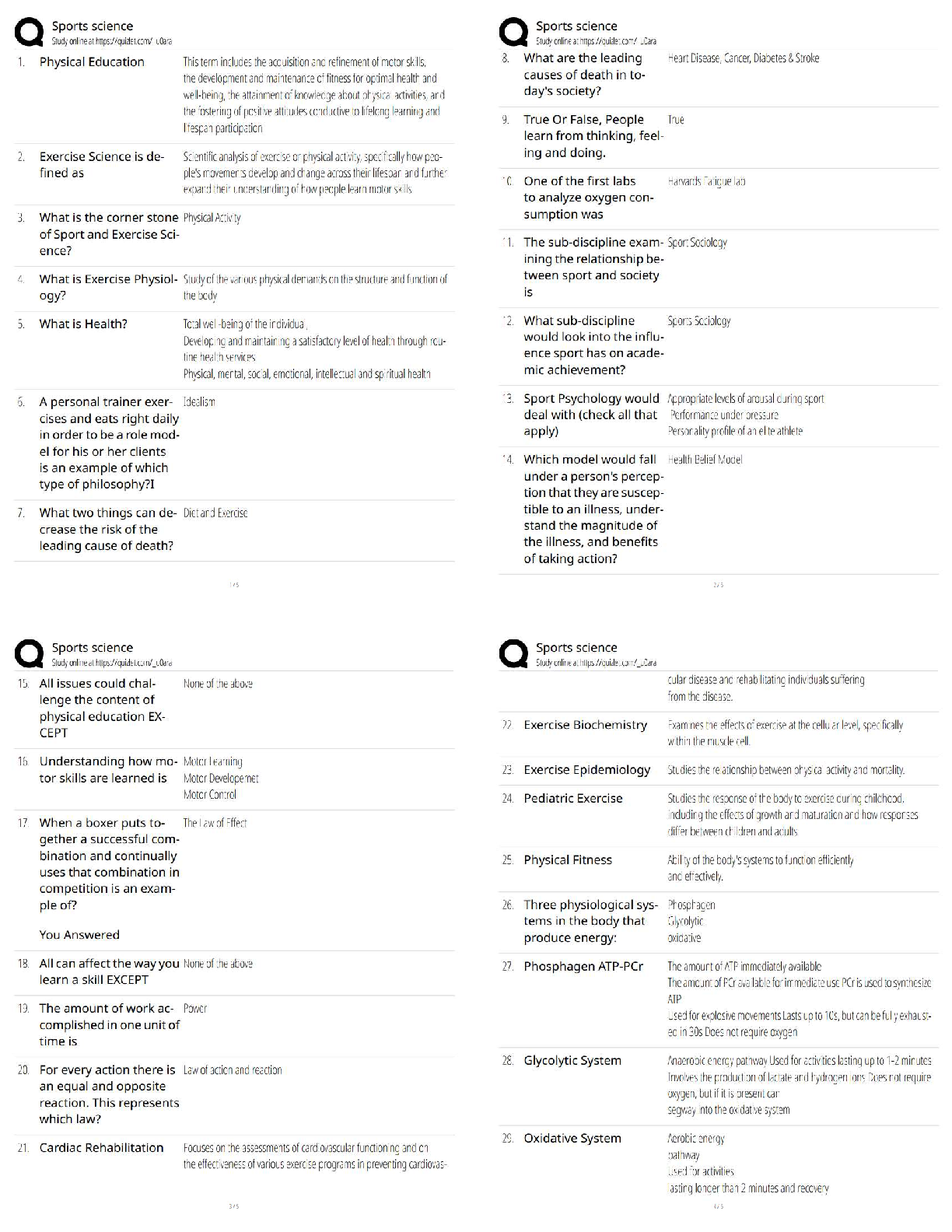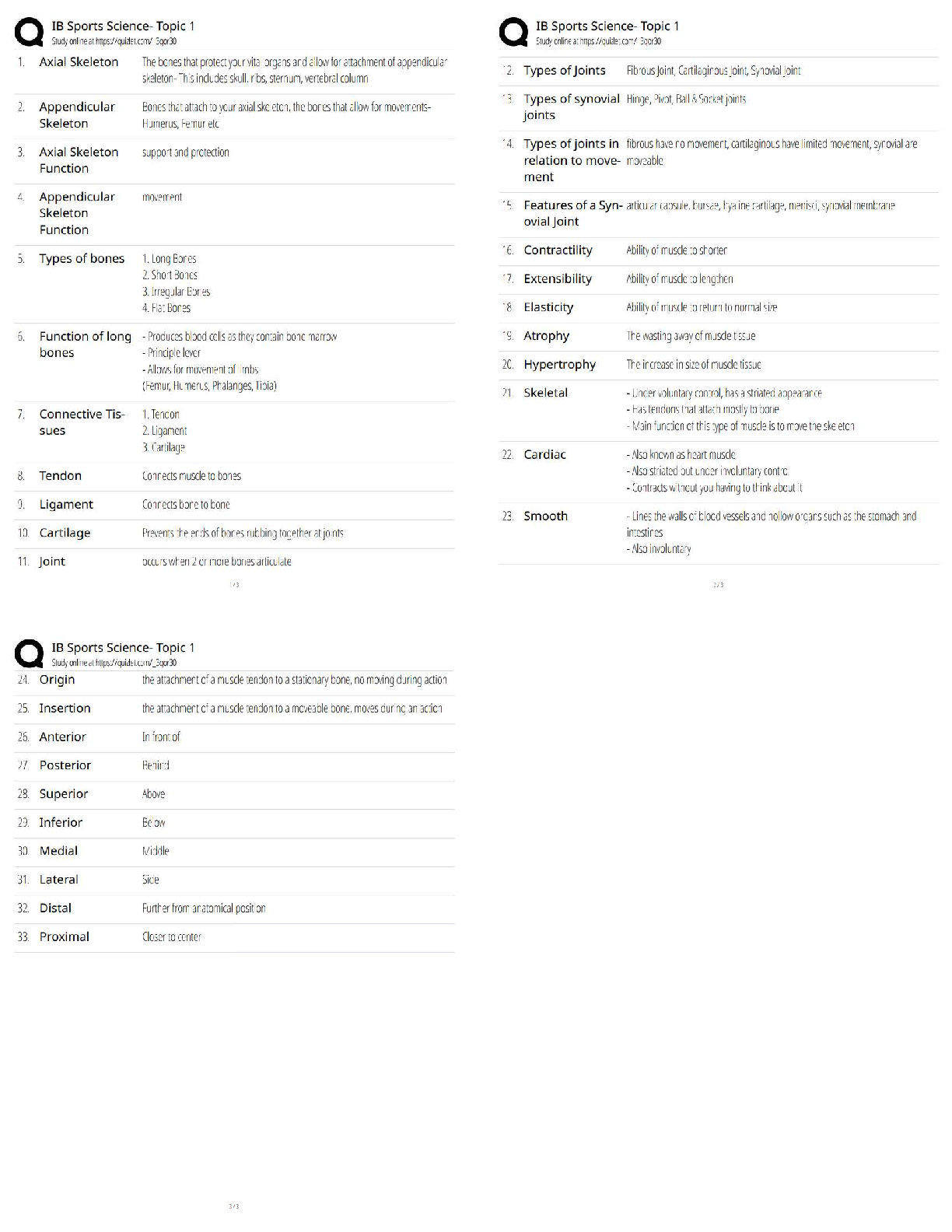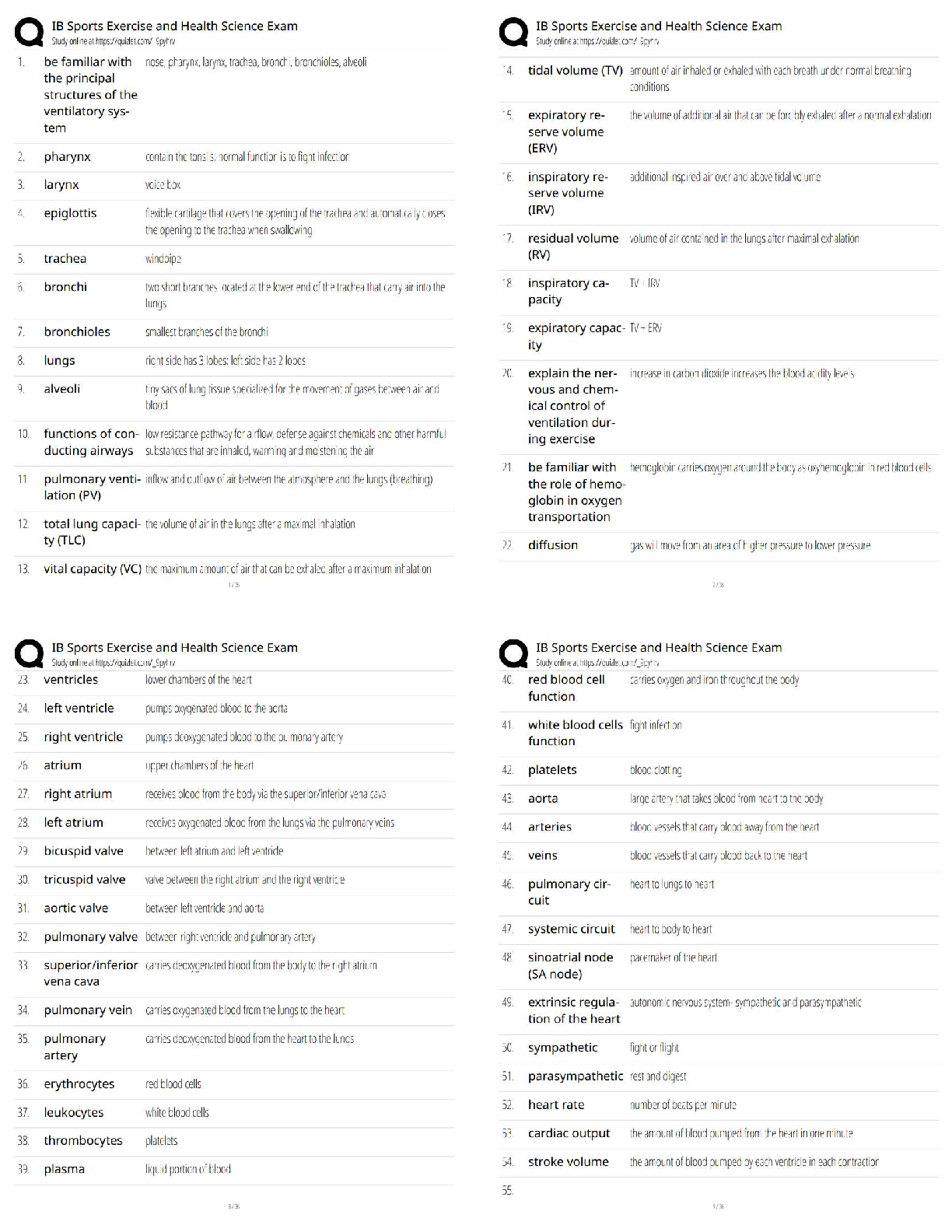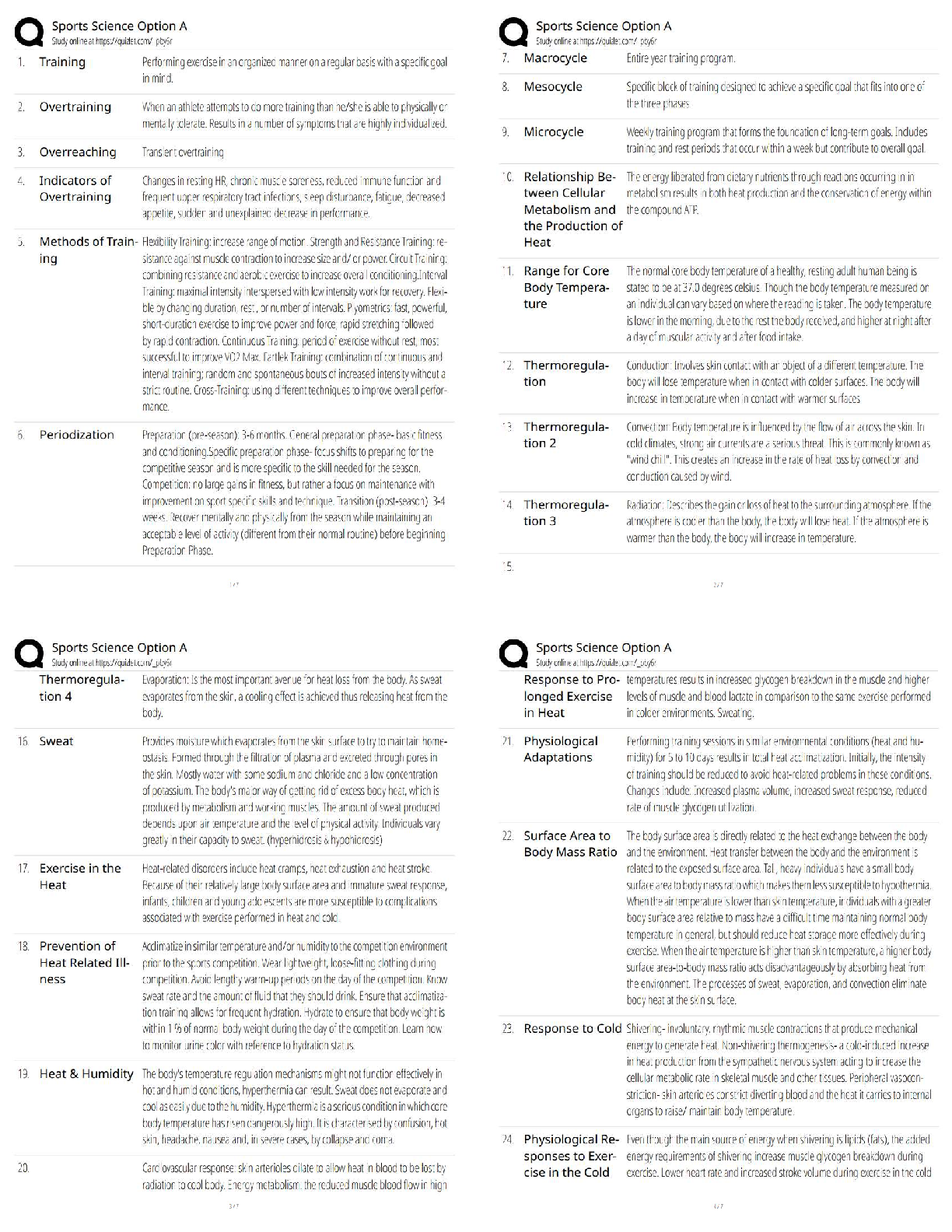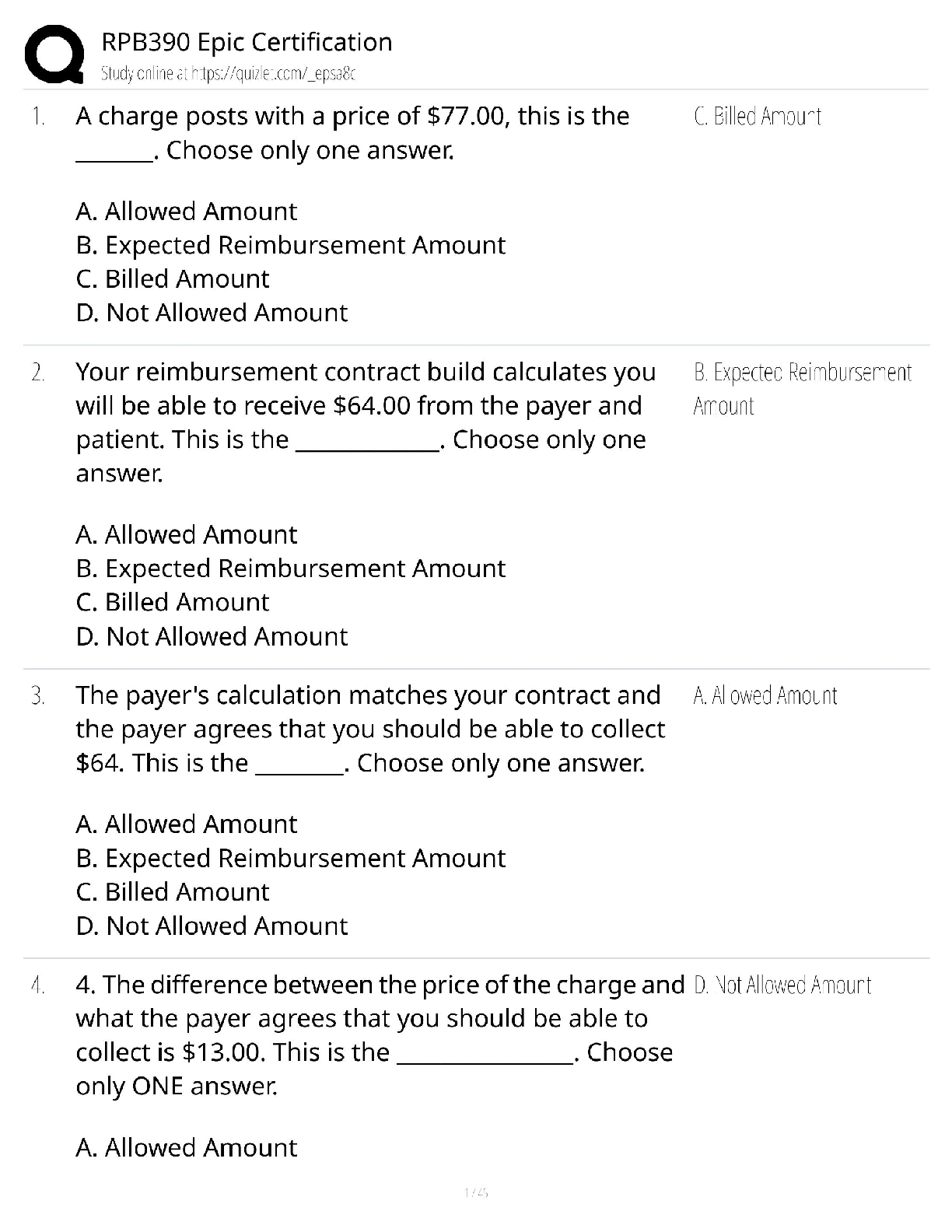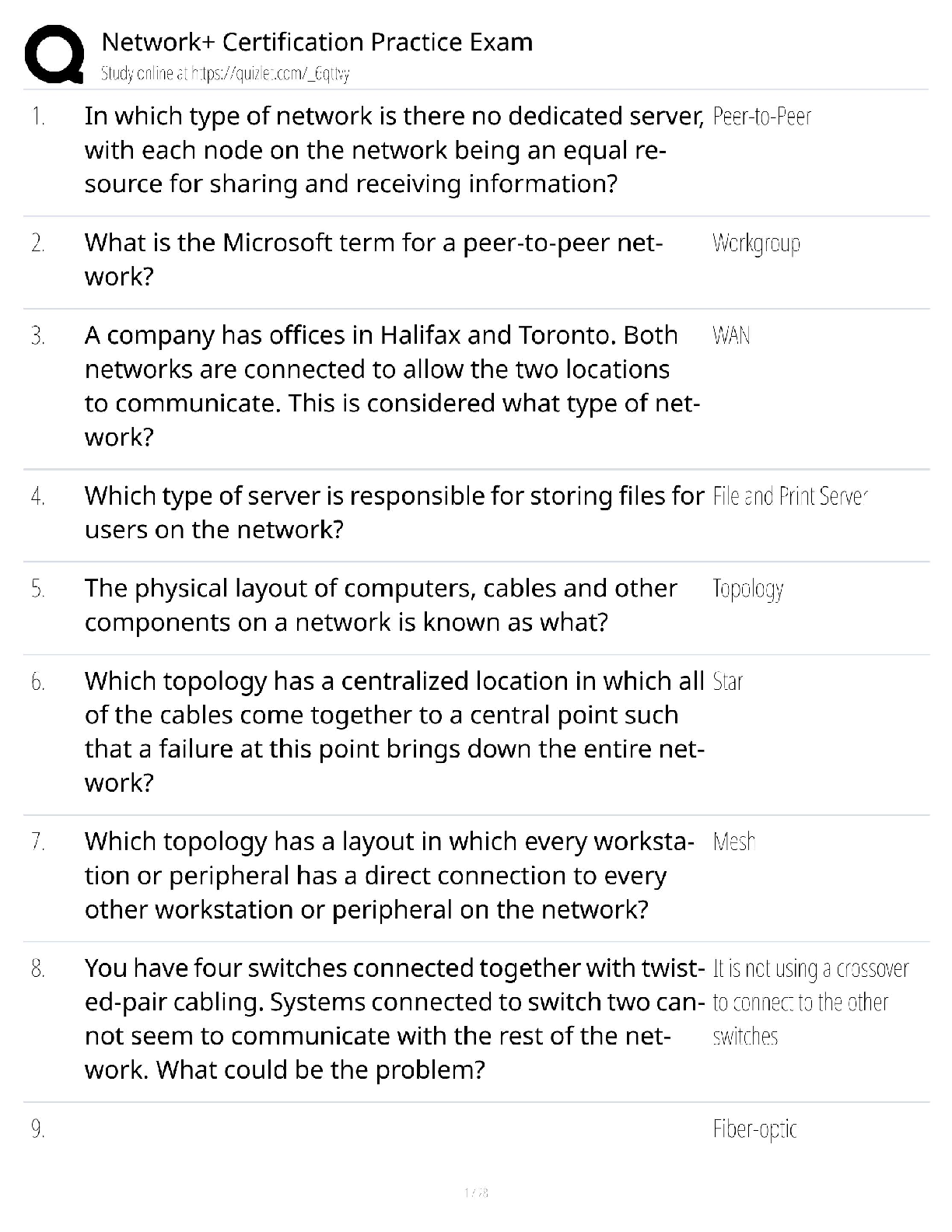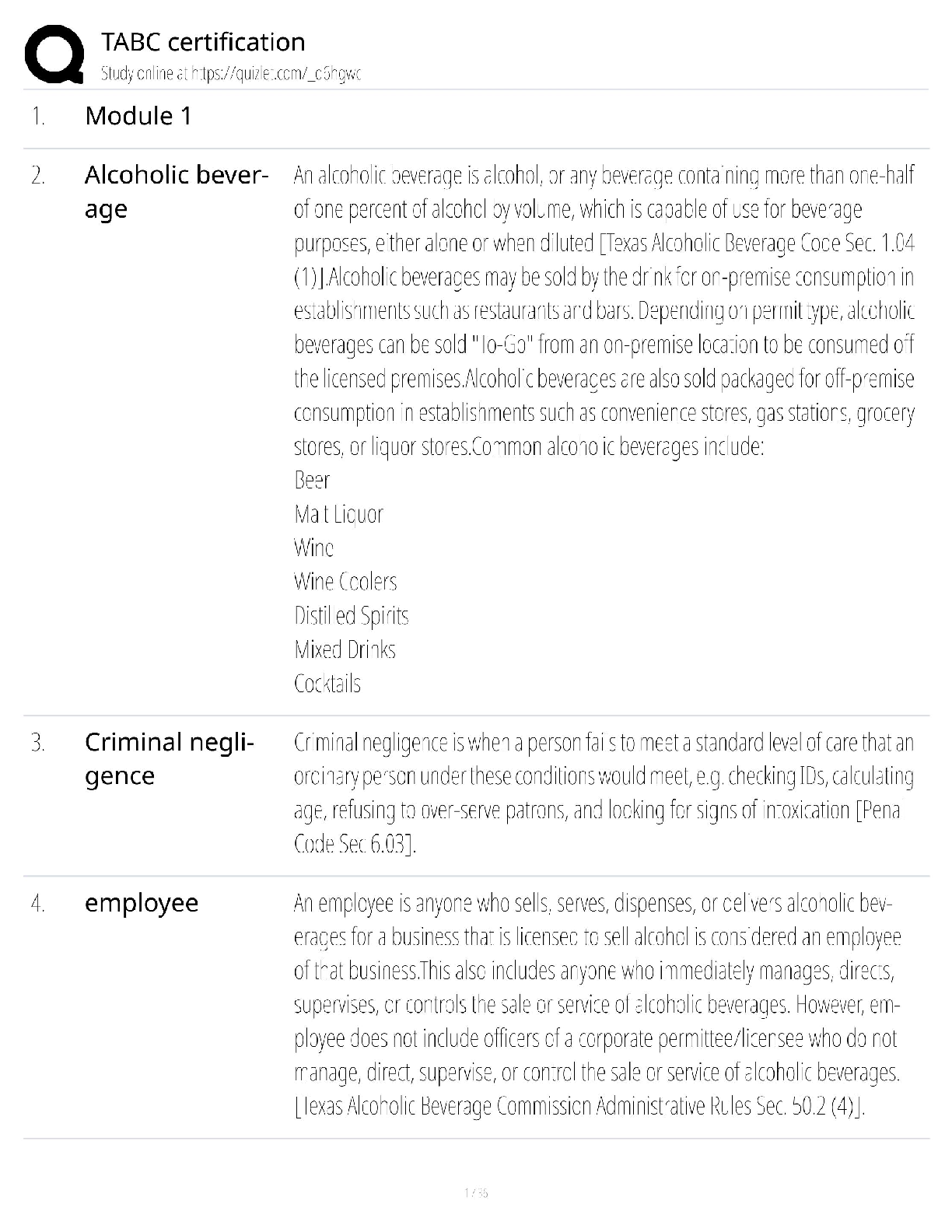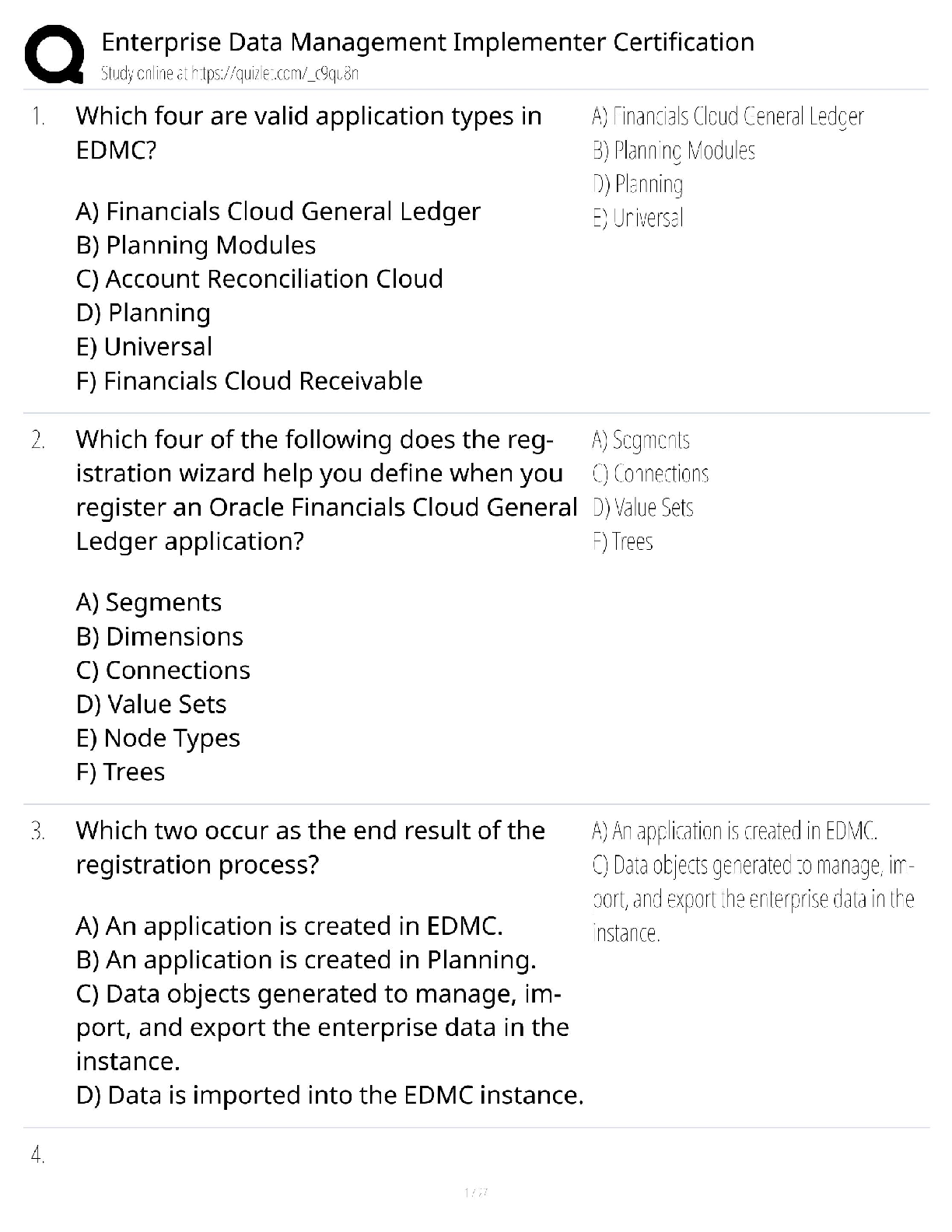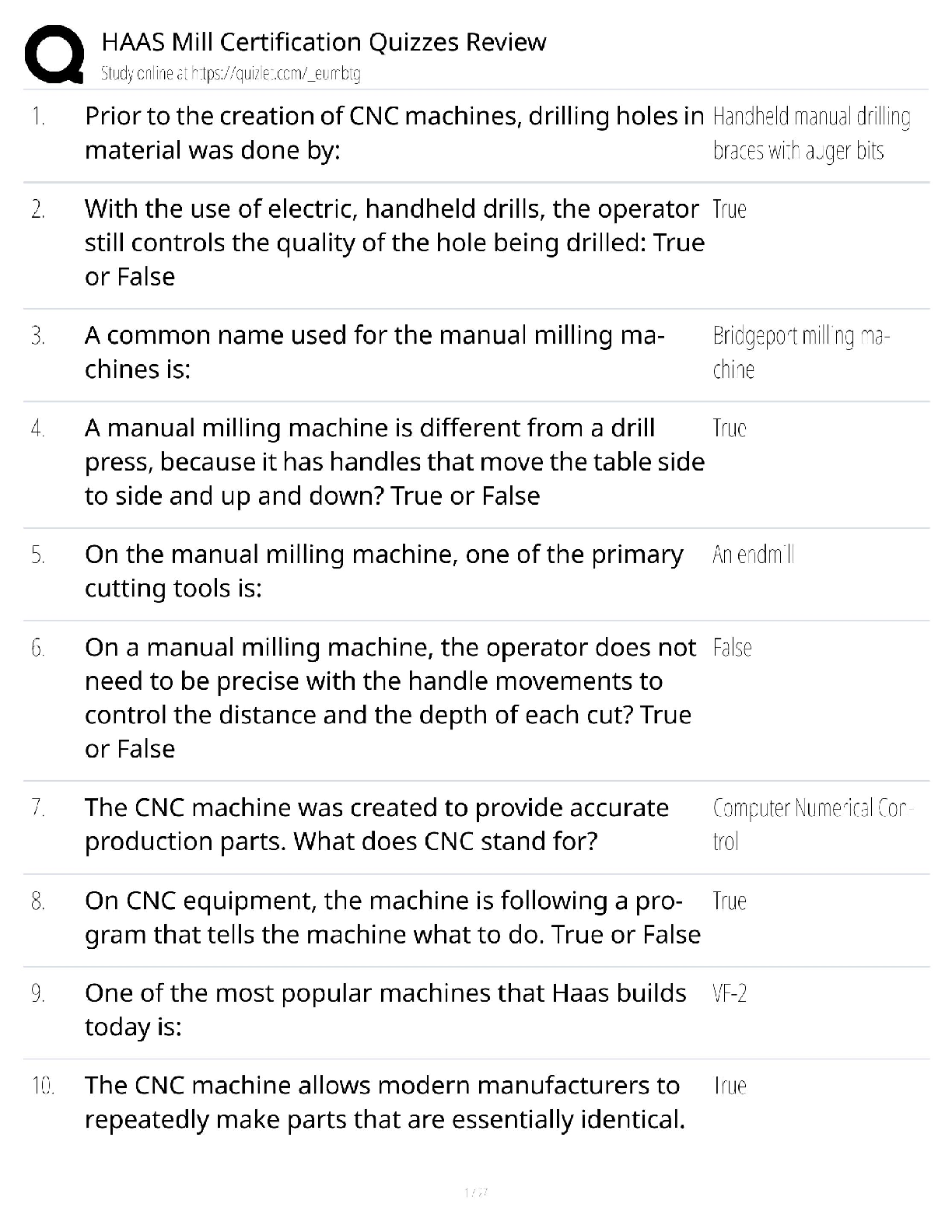*NURSING > QUESTIONS & ANSWERS > (SOLVED MCQ) NURSING 01 Chapter 26 The Child with Hematologic or Immunologic Dysfunction (All)
(SOLVED MCQ) NURSING 01 Chapter 26 The Child with Hematologic or Immunologic Dysfunction
Document Content and Description Below
(SOLVED MCQ) NURSING 01 Chapter 26 The Child with Hematologic or Immunologic Dysfunction Chapter 26: The Child with Hematologic or Immunologic Dysfunction MULTIPLE CHOICE 1. Which child should the n ... urse document as being anemic? a. 7-year-old child with a hemoglobin of 11.5 g/dl b. c. 3-year-old child with a hemoglobin of 12 g/dl 14-year-old child with a hemoglobin of 10 g/dl d. 1-year-old child with a hemoglobin of 13 g/dl ANS: D Anemia is a condition in which the number of red blood cells, or hemoglobin concentration, is reduced below the normal values for age. Anemia is defined as a hemoglobin level below 10 or 11 g/dl. The child with a hemoglobin of 10 g/dl would be considered anemic. The normal hemoglobin for a child after 2 years of age is 11.5 to 15.5 g/dl. PTS: 1 DIF: Cognitive Level: Understand REF: 869 TOP: Integrated Process: Nursing Process: Assessment MSC: Area of Client Needs: Physiologic Integrity: Physiologic Adaptation 2. Several blood tests are ordered for a preschool child with severe anemia. The child is crying and upset because of memories of the venipuncture done at the clinic 2 days ago. The nurse should explain: a. venipuncture discomfort is very brief. b. only one venipuncture will be needed. c. topical application of local anesthetic can eliminate venipuncture pain. d. most blood tests on children require only a finger puncture because a small amount of blood is needed. ANS: C Preschool children are concerned with both pain and the loss of blood. When preparing the child for venipuncture, the nurse will use a topical anesthetic to eliminate any pain. This is a traumatic experience for preschool children. They are concerned about their bodily integrity. A local anesthetic should be used, and a bandage should be applied to maintain bodily integrity. The nurse should not promise one attempt in case multiple attempts are required. Both finger punctures and venipunctures are traumatic for children. Both require preparation. PTS: 1 DIF: Cognitive Level: Apply TOP: Integrated Process: Teaching/Learning MSC: Area of Client Needs: Health Promotion and Maintenance 3. The nurse is planning activity for a 4-year-old child with anemia. Which activity should the nurse plan for this child? a. Game of “hide and seek” in the children’s outdoor play area b. Participation in dance activities in the playroom Puppet play in the child’s room c. d. A walk down to the hospital lobby ANS: C REF: 871Because the basic pathologic process in anemia is a decrease in oxygen-carrying capacity, an important nursing responsibility is to assess the child’s energy level and minimize excess demands. The child’s level of tolerance for activities of daily living and play is assessed, and adjustments are made to allow as much self-care as possible without undue exertion. Puppet play in the child’s room would not be overly tiring. Hide and seek, dancing, and walking to the lobby would not conserve the anemic child’s energy. PTS: 1 DIF: Cognitive Level: Apply REF: 871 TOP: Integrated Process: Nursing Process: Implementation MSC: Area of Client Needs: Physiologic Integrity: Physiologic Adaptation 4. The nurse is teaching parents about the importance of iron in a toddler’s diet. Which explains why iron deficiency anemia is common during toddlerhood? a. Milk is a poor source of iron. b. Iron cannot be stored during fetal development. c. Fetal iron stores are depleted by age 1 month. d. Dietary iron cannot be started until age 12 months. ANS: A Children between the ages of 12 and 36 months are at risk for anemia because cow’s milk is a major component of their diet and it is a poor source of iron. Iron is stored during fetal development, but the amount stored depends on maternal iron stores. Fetal iron stores are usually depleted by age 5 to 6 months. Dietary iron can be introduced by breastfeeding, iron- fortified formula, and cereals during the first 12 months of life. PTS: 1 DIF: Cognitive Level: Understand REF: 872 TOP: Integrated Process: Teaching/Learning MSC: Area of Client Needs: Physiologic Integrity: Physiologic Adaptation 5. The nurse is teaching parents of an infant about the causes of iron deficiency anemia. Which statement best describes iron deficiency anemia in infants? a. It is caused by depression of the hematopoietic system. b. c. It is easily diagnosed because of an infant’s emaciated appearance. Clinical manifestations are similar regardless of the cause of the anemia. d. Clinical manifestations result from a decreased intake of milk and the premature addition of solid foods. ANS: C In iron deficiency anemia, the child’s clinical appearance is a result of the anemia, not the underlying cause. Usually the hematopoietic system is not depressed in iron deficiency anemia. The bone marrow produces red cells that are smaller and contain less hemoglobin than normal red cells. Children who are iron deficient from drinking excessive quantities of milk are usually pale and overweight. They are receiving sufficient calories, but are deficient in essential nutrients. The clinical manifestations result from decreased intake of iron-fortified solid foods and an excessive intake of milk. PTS: 1 DIF: Cognitive Level: Apply REF: 872 TOP: Integrated Process: Teaching/Learning MSC: Area of Client Needs: Physiologic Integrity: Physiologic Adaptation6. Which should the nurse include when teaching the mother of a 9-month-old infant about administering liquid iron preparations? a. They should be given with meals. b. They should be stopped immediately if nausea and vomiting occur. c. Adequate dosage will turn the stools a tarry green color. d. Allow preparation to mix with saliva and bathe the teeth before swallowing. ANS: C The nurse should prepare the mother for the anticipated change in the child’s stools. If the iron dose is adequate, the stools will become a tarry green color. The lack of the color change may indicate insufficient iron. The iron should be given in two divided doses between meals when the presence of free hydrochloric acid is greatest. Iron is absorbed best in an acidic environment. Vomiting and diarrhea may occur with iron administration. If these occur, the iron should be given with meals, and the dosage reduced, then gradually increased as the child develops tolerance. Liquid preparations of iron stain the teeth. They should be administered through a straw and the mouth rinsed after administration. PTS: 1 DIF: Cognitive Level: Apply REF: 873 TOP: Integrated Process: Teaching/Learning MSC: Area of Client Needs: Physiologic Integrity: Pharmacologic and Parenteral Therapy 7. Iron dextran is ordered for a young child with severe iron deficiency anemia. Nursing considerations include to: a. administer with meals. b. administer between meals. c. inject deeply into a large muscle. d. massage injection site for 5 minutes after administration of drug. ANS: C Iron dextran is a parenteral form of iron. When administered intramuscularly, it must be injected into a large muscle. Iron dextran is for intramuscular or intravenous (IV) administration. The site should not be massaged to prevent leakage, potential irritation, and staining of the skin. PTS: 1 DIF: Cognitive Level: Apply REF: 873 TOP: Integrated Process: Nursing Process: Implementation MSC: Area of Client Needs: Physiologic Integrity: Pharmacologic and Parenteral Therapy 8. The nurse is recommending how to prevent iron deficiency anemia in a healthy, term, breast-fed infant. Which should be suggested? a. Iron (ferrous sulfate) drops after age 1 month b. c. Iron-fortified commercial formula by age 4 to 6 months Iron-fortified infant cereal by age 2 months d. Iron-fortified infant cereal by age 4 to 6 months ANS: D Breast milk supplies inadequate iron for growth and development after age 5 months. Supplementation is necessary at this time. The mother can supplement the breastfeeding with iron-fortified infant cereal. Iron supplementation or the introduction of solid foods in a breast- fed baby is not indicated. Providing iron-fortified commercial formula by age 4 to 6 months should be done only if the mother is choosing to discontinue breastfeeding.PTS: 1 DIF: Cognitive Level: Apply REF: 873 TOP: Integrated Process: Teaching/Learning MSC: Area of Client Needs: Physiologic Integrity: Basic Care and Comfort 9. Parents of a child with sickle cell anemia ask the nurse, “What happens to the hemoglobin in sickle cell anemia?” Which statement by the nurse explains the disease process?” a. Normal adult hemoglobin is replaced by abnormal hemoglobin. b. There is a lack of cellular hemoglobin being produced. c. There is a deficiency in the production of globulin chains. d. The size and depth of the hemoglobin are affected. ANS: A Sickle cell anemia is one of a group of diseases collectively called hemoglobinopathies, in which normal adult hemoglobin is replaced by abnormal hemoglobin. Aplastic anemia is a lack of cellular elements being produced. Thalassemia major refers to a variety of inherited disorders characterized by deficiencies in production of certain globulin chains. Iron deficiency anemia affects the size and depth of the color. PTS: 1 DIF: Cognitive Level: Apply REF: 873 TOP: Integrated Process: Teaching/Learning MSC: Area of Client Needs: Physiologic Integrity: Physiologic Adaptation 10. When both parents have sickle cell trait, which is the chance their children will have sickle cell anemia? a. 25% b. 50% c. 75% d. 100% ANS: A Sickle cell anemia is inherited in an autosomal recessive pattern. If both parents have sickle cell trait (one copy of the sickle cell gene), then for each pregnancy, a 25% chance exists that their child will be affected with sickle cell disease. With each pregnancy, a 50% chance exists that the child will have sickle cell trait. Percentages of 75% and 100% are too high for the children of parents who have sickle cell trait. PTS: 1 DIF: Cognitive Level: Analyze REF: 874 TOP: Integrated Process: Nursing Process: Assessment MSC: Area of Client Needs: Physiologic Integrity: Reduction of Risk Potential 11. The nurse is conducting a staff in-service on sickle cell anemia. Which describes the pathologic changes of sickle cell anemia? a. Sickle-shaped cells carry excess oxygen. b. Sickle-shaped cells decrease blood viscosity. Increased red blood cell destruction occurs. c. d. Decreased adhesion of sickle-shaped cells occurs. ANS: CThe clinical features of sickle cell anemia are primarily the result of increased red blood cell destruction and obstruction caused by the sickle-shaped red blood cells. Sickled red cells have decreased oxygen-carrying capacity and transform into the sickle shape in conditions of low oxygen tension. When the sickle cells change shape, they increase the viscosity in the area where they are involved in the microcirculation. Increased adhesion and entanglement of cells occurs. PTS: 1 DIF: Cognitive Level: Apply REF: 874 TOP: Integrated Process: Teaching/Learning MSC: Area of Client Needs: Physiologic Integrity: Physiologic Adaptation 12. Which clinical manifestation should the nurse expect when a child with sickle cell anemia experiences an acute vasoocclusive crisis? a. Circulatory collapse b. Cardiomegaly, systolic murmurs c. Hepatomegaly, intrahepatic cholestasis d. Painful swelling of hands and feet; painful joints ANS: D A vasoocclusive crisis is characterized by severe pain in the area of involvement. If in the extremities, painful swelling of the hands and feet is seen; if in the abdomen, severe pain resembles that of acute surgical abdomen; and if in the head, stroke and visual disturbances occur. Circulatory collapse results from sequestration crises. Cardiomegaly, systolic murmurs, hepatomegaly, and intrahepatic cholestasis result from chronic vasoocclusive phenomena. PTS: 1 DIF: Cognitive Level: Understand REF: 874 TOP: Integrated Process: Nursing Process: Assessment MSC: Area of Client Needs: Physiologic Integrity: Physiologic Adaptation 13. Meperidine (Demerol) is not recommended for children in sickle cell crisis because it: a. may induce seizures. b. is easily addictive. c. is not adequate for pain relief. d. is given by intramuscular injection. ANS: A A metabolite of meperidine, normeperidine, is a central nervous system stimulant that produces anxiety, tremors, myoclonus, and generalized seizures when it accumulates with repetitive dosing. Patients with sickle cell disease are particularly at risk for normeperidine- induced seizures. Meperidine is no more addictive than other narcotic agents. Meperidine is adequate for pain relief. It is available for IV infusion. PTS: 1 DIF: Cognitive Level: Understand REF: 876 TOP: Integrated Process: Nursing Process: Planning MSC: Area of Client Needs: Physiologic Integrity: Pharmacologic and Parenteral Therapy 14. A school-age child is admitted in vasoocclusive sickle cell crisis. The child’s care should include: a. correction of acidosis. b. adequate hydration and pain management. c. pain management and administration of heparin.d. adequate oxygenation and replacement of factor VIII. ANS: B The management of crises includes adequate hydration, minimization of energy expenditures, pain management, electrolyte replacement, and blood component therapy if indicated. Hydration and pain control are two of the major goals of therapy. The acidosis will be corrected as the crisis is treated. Heparin and factor VIII is not indicated in the treatment of vasoocclusive sickle cell crisis. Oxygen may prevent further sickling, but it is not effective in reversing sickling because it cannot reach the clogged blood vessels. PTS: 1 DIF: Cognitive Level: Apply REF: 875-876 TOP: Integrated Process: Nursing Process: Implementation MSC: Area of Client Needs: Physiologic Integrity: Physiologic Adaptation 15. The parents of a child hospitalized with sickle cell anemia tell the nurse that they are concerned about narcotic analgesics causing addiction. Which is appropriate for the nurse to explain about narcotic analgesics? a. Are often ordered but not usually needed b. Rarely cause addiction because they are medically indicated c. Are given as a last resort because of the threat of addiction d. Are used only if other measures, such as ice packs, are ineffective ANS: B The pain of sickle cell anemia is best treated by a multidisciplinary approach. Mild to moderate pain can be controlled by ibuprofen and acetaminophen. When narcotics are indicated, they are titrated to effect and are given around the clock. Patient-controlled analgesia reinforces the patient’s role and responsibility in managing the pain and provides flexibility in dealing with pain. Few, if any, patients who receive opioids for severe pain become behaviorally addicted to the drug. Narcotics are often used because of the severe nature of the pain of vasoocclusive crisis. Ice is contraindicated because of its vasoconstrictive effects. PTS: 1 DIF: Cognitive Level: Apply REF: 879 TOP: Integrated Process: Teaching/Learning MSC: Area of Client Needs: Physiologic Integrity: Pharmacologic and Parenteral Therapy 16. Which statement best describes -thalassemia major (Cooley anemia)? a. All formed elements of the blood are depressed. b. c. Inadequate numbers of red blood cells are present. Increased incidence occurs in families of Mediterranean extraction. d. Increased incidence occurs in persons of West African descent. ANS: C Individuals who live near the Mediterranean Sea and their descendants have the highest incidence of thalassemia. An overproduction of red cells occurs. Although numerous, the red cells are relatively unstable. Sickle cell disease is common in persons of West African descent. PTS: 1 DIF: Cognitive Level: Understand REF: 881 TOP: Integrated Process: Nursing Process: Assessment MSC: Area of Client Needs: Physiologic Integrity: Physiologic Adaptation17. Chelation therapy is begun on a child with -thalassemia major. The purpose of this therapy is to: a. treat the disease. b. eliminate excess iron. c. decrease risk of hypoxia. d. manage nausea and vomiting. ANS: B A complication of the frequent blood transfusions in thalassemia is iron overload. Chelation therapy with deferoxamine (an iron-chelating agent) is given with oral supplements of vitamin C to increase iron excretion. Chelation therapy treats the side effect of the disease management. Decreasing the risk of hypoxia and managing nausea and vomiting are not the purposes of chelation therapy. PTS: 1 DIF: Cognitive Level: Understand REF: 882 TOP: Integrated Process: Nursing Process: Implementation MSC: Area of Client Needs: Physiologic Integrity: Pharmacologic and Parenteral Therapy 18. In which of the conditions are all the formed elements of the blood simultaneously depressed? a. Aplastic anemia b. Sickle cell anemia c. Thalassemia major d. Iron deficiency anemia ANS: A Aplastic anemia refers to a bone marrow–failure condition in which the formed elements of the blood are simultaneously depressed. Sickle cell anemia is a hemoglobinopathy in which normal adult hemoglobin is partly or completely replaced by abnormal sickle hemoglobin. Thalassemia major is a group of blood disorders characterized by deficiency in the production rate of specific hemoglobin globin chains. Iron deficiency anemia results in a decreased amount of circulating red cells. PTS: 1 DIF: Cognitive Level: Understand REF: 882 TOP: Integrated Process: Nursing Process: Assessment MSC: Area of Client Needs: Physiologic Integrity: Physiologic Adaptation 19. A possible cause of acquired aplastic anemia in children is: a. drugs. b. c. injury. deficient diet. d. congenital defect. ANS: A Drugs, such as chemotherapeutic agents and several antibiotics (e.g., chloramphenicol), can cause aplastic anemia. Injury, deficient diet, and congenital defect are not causative agents in acquired aplastic anemia. PTS: 1 DIF: Cognitive Level: Understand REF: 883 TOP: Integrated Process: Nursing Process: Assessment MSC: Area of Client Needs: Physiologic Integrity: Pharmacologic and Parenteral Therapy [Show More]
Last updated: 3 years ago
Preview 1 out of 19 pages

Buy this document to get the full access instantly
Instant Download Access after purchase
Buy NowInstant download
We Accept:

Reviews( 0 )
$12.00
Can't find what you want? Try our AI powered Search
Document information
Connected school, study & course
About the document
Uploaded On
Sep 08, 2021
Number of pages
19
Written in
All
Additional information
This document has been written for:
Uploaded
Sep 08, 2021
Downloads
0
Views
147

.png)



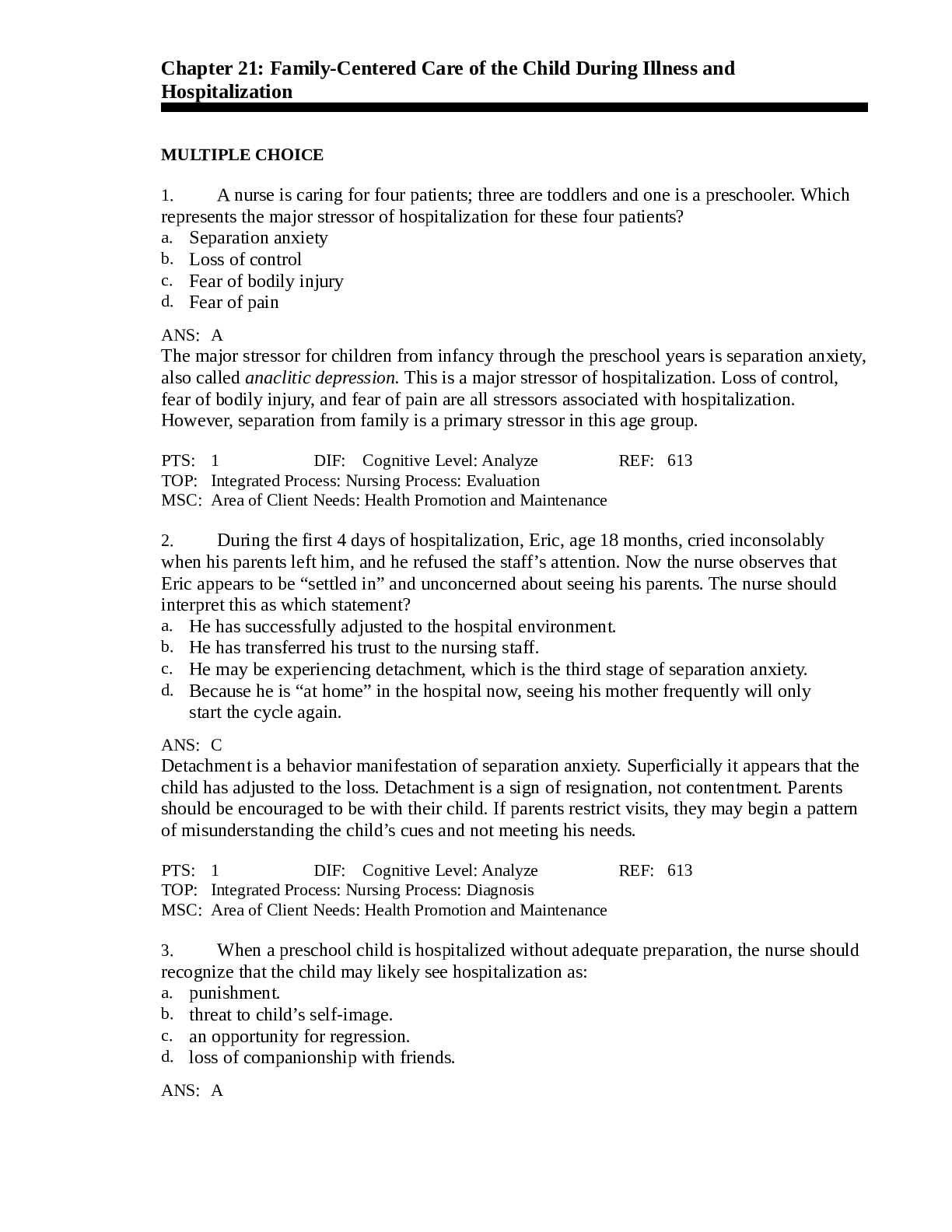


.png)

